EPAM Systems Bundle
How Does EPAM Systems Win in the Digital Transformation Arena?
Explore the intricate sales and marketing strategies that have propelled EPAM Systems to the forefront of the digital platform engineering landscape. From its humble beginnings to its current status as a global powerhouse, EPAM's approach to business development is a masterclass in strategic execution. This analysis delves into the tactics behind its impressive growth and sustained success.
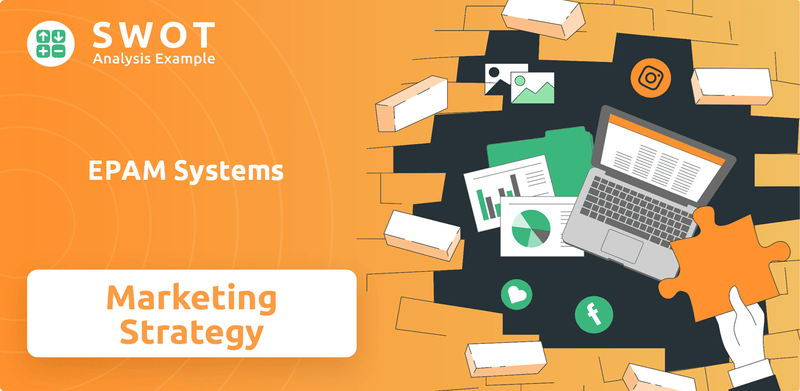
This deep dive into EPAM's sales and marketing strategies will uncover how it cultivates its brand, generates leads, and positions itself in a competitive market. We'll examine its EPAM Systems SWOT Analysis, dissecting its strengths, weaknesses, opportunities, and threats. Understanding EPAM's approach offers valuable insights for anyone looking to optimize their own sales process and marketing campaigns, conduct thorough market analysis, and refine their client acquisition strategies.
How Does EPAM Systems Reach Its Customers?
The sales channels of EPAM Systems primarily revolve around a direct sales model, which is crucial for their complex digital transformation and software engineering services. This approach allows for a deep understanding of client needs and facilitates long sales cycles, essential for high-value contracts. Their sales teams are structured to target specific industries and client tiers, focusing on building strong relationships with C-suite executives and IT decision-makers. The company's sales strategy is designed to offer tailored solutions and robust contract negotiations, ensuring client satisfaction and retention.
In addition to direct sales, EPAM leverages strategic partnerships and alliances to broaden its reach and capabilities. These collaborations include partnerships with major technology vendors like cloud providers (AWS, Microsoft Azure, Google Cloud) and enterprise software companies. These alliances often involve joint go-to-market strategies, lead sharing, and integrated service offerings, which help EPAM access new client segments and enhance its solution ecosystem. The evolution of these channels reflects the increasing complexity of modern digital transformation initiatives.
EPAM's focus on both direct sales and strategic partnerships highlights its comprehensive approach to business development and market penetration. This dual strategy allows the company to address a wide range of client needs while maintaining a strong presence in the competitive IT services market. The company's ability to adapt and evolve its sales channels is a key factor in its sustained growth.
EPAM's primary sales channel involves direct engagement with enterprise clients. This approach allows for tailored solutions and robust contract negotiations. The sales teams target specific industries and client tiers, focusing on building relationships with key decision-makers.
EPAM collaborates with technology vendors and consulting firms to expand its reach. These partnerships involve joint go-to-market strategies and integrated service offerings. This approach helps access new client segments and enhance its solution ecosystem.
The sales force is structured to target specific industries and client tiers. This structure fosters strong relationships with C-suite executives and IT decision-makers. This structure allows for more effective client engagement and solution delivery.
Partnerships enable EPAM to offer more comprehensive solutions and address broader market needs. Strategic alliances contribute to sustained growth in a competitive environment. These collaborations are vital for expanding service offerings and market reach.
EPAM's sales strategy is heavily reliant on direct engagement, with a focus on building strong relationships with clients. The company's marketing strategy complements this with targeted campaigns and industry-specific content. Effective sales and marketing alignment is critical for driving growth.
- Direct Sales Focus: Dedicated sales teams engaging directly with enterprise clients.
- Strategic Partnerships: Collaborations with technology vendors and consulting firms.
- Industry-Specific Targeting: Sales teams structured to target specific industries and client tiers.
- Digital Marketing: Leveraging digital channels for lead generation and brand positioning.
EPAM Systems SWOT Analysis
- Complete SWOT Breakdown
- Fully Customizable
- Editable in Excel & Word
- Professional Formatting
- Investor-Ready Format
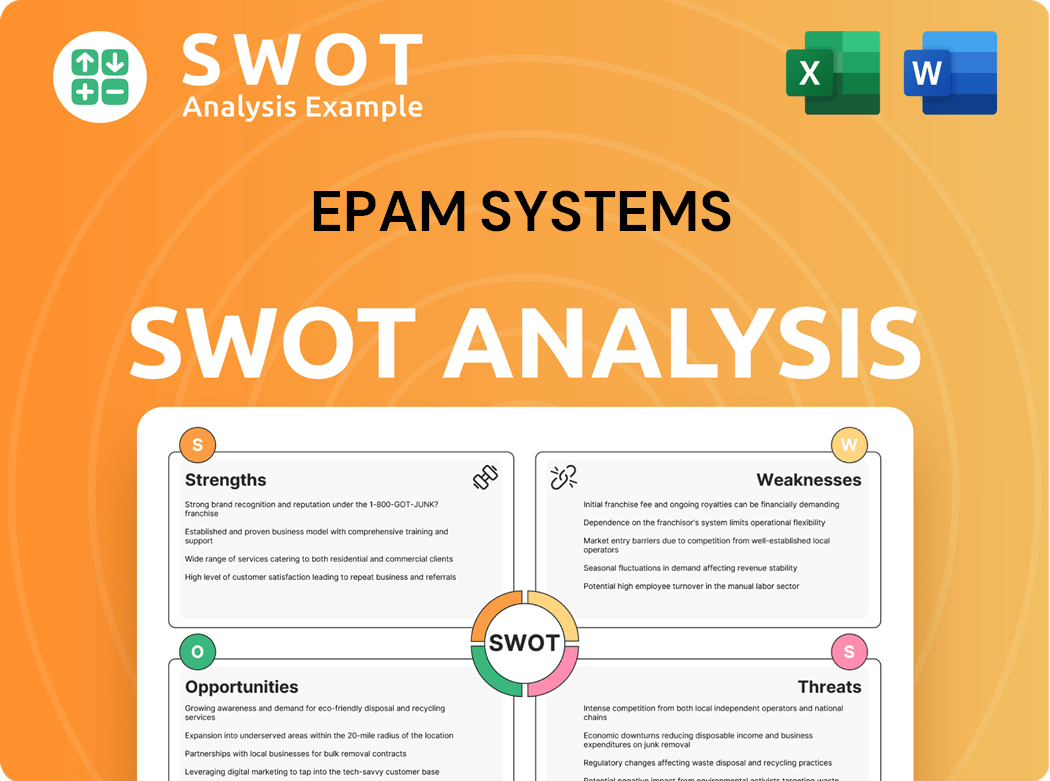
What Marketing Tactics Does EPAM Systems Use?
The marketing tactics employed by EPAM Systems are designed to boost brand awareness, generate leads, and drive sales within the enterprise technology sector. Their approach is a blend of digital and traditional methods, with a strong emphasis on digital strategies. This integrated approach reflects the evolving preferences of its target audience and the need for data-driven insights in today's market.
EPAM's EPAM Systems marketing strategy heavily relies on content marketing, SEO, and paid advertising. They also actively engage on social media platforms, particularly LinkedIn. The company uses data analytics to refine its marketing efforts, ensuring that content and messaging are highly relevant to specific client profiles. This data-driven approach allows for continuous improvement and optimization of their marketing campaigns.
EPAM Systems' EPAM Systems sales strategy is closely aligned with its marketing efforts, creating a cohesive approach to client acquisition and engagement. Their participation in industry events and conferences supports direct networking and reinforces brand presence. Through this integrated marketing mix, EPAM aims to maximize its reach and impact within the competitive enterprise technology market.
EPAM uses a variety of content formats to showcase its expertise. These include thought leadership articles, whitepapers, case studies, webinars, and industry reports. This content focuses on areas like AI, cloud computing, data analytics, and digital transformation.
The company distributes its content through its corporate website, professional networking platforms like LinkedIn, and targeted email marketing campaigns. Their strong presence on LinkedIn is a key channel for engaging with potential clients and showcasing company culture.
EPAM employs search engine optimization (SEO) to ensure its content ranks well for relevant industry keywords. Paid advertising is used for targeted reach and lead generation. This includes advertising in industry-specific publications and on professional platforms.
EPAM utilizes analytics tools to track website traffic, content engagement, lead conversion rates, and campaign performance. This data is crucial for customer segmentation and personalization efforts. This allows them to deliver relevant content and messaging.
The company participates in key industry events and conferences. This includes both attending and speaking, to foster direct networking and reinforce its brand presence. This helps in building relationships and increasing visibility.
EPAM's marketing strategy prioritizes digital engagement and data-driven insights. This reflects the preferences and information consumption habits of its target enterprise audience. This integrated approach helps in achieving its business goals.
EPAM's marketing tactics are designed to reach its target audience effectively. The company focuses on digital channels, content creation, and data analysis. These strategies contribute to its overall EPAM Systems business development and market presence.
- Content Marketing: Creating valuable content like whitepapers and case studies to establish thought leadership.
- Digital Channels: Utilizing websites, LinkedIn, and email campaigns for content distribution and lead generation.
- SEO and Paid Advertising: Employing SEO to improve search rankings and using paid advertising for targeted reach.
- Data Analytics: Tracking and analyzing data to refine marketing efforts and personalize client interactions.
- Industry Events: Participating in conferences to network and strengthen brand presence.
- Integrated Approach: Combining various tactics to ensure a cohesive and effective marketing strategy.
For more details on the company's background, you can read Brief History of EPAM Systems.
EPAM Systems PESTLE Analysis
- Covers All 6 PESTLE Categories
- No Research Needed – Save Hours of Work
- Built by Experts, Trusted by Consultants
- Instant Download, Ready to Use
- 100% Editable, Fully Customizable
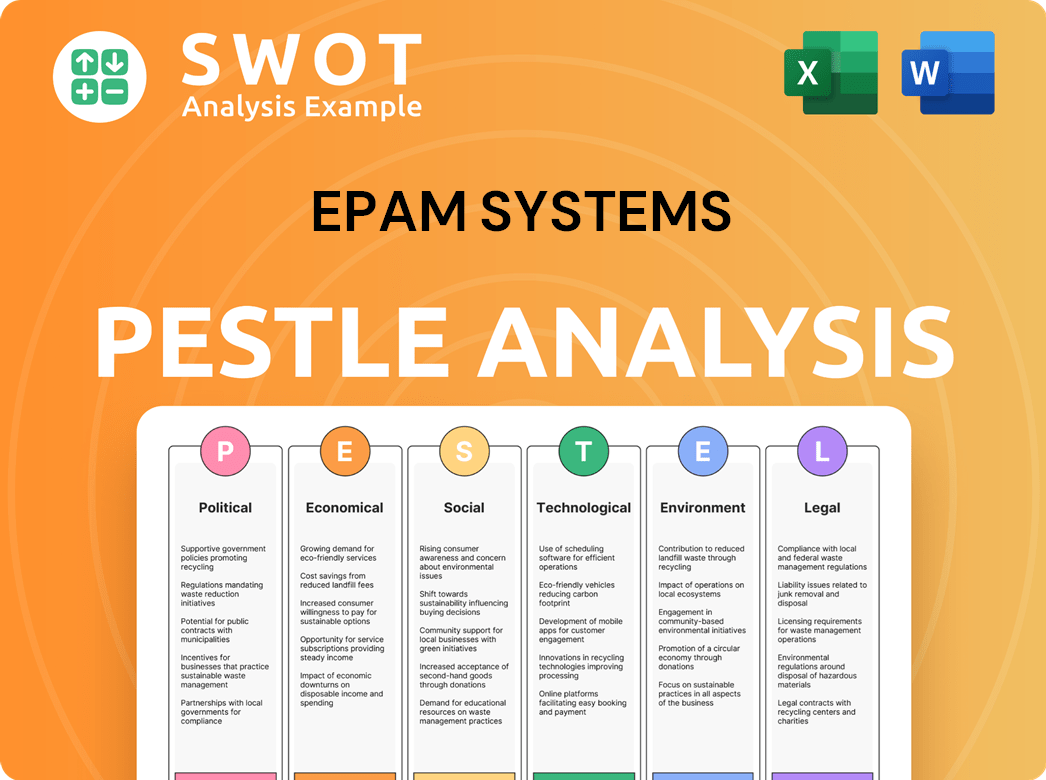
How Is EPAM Systems Positioned in the Market?
EPAM Systems strategically positions itself as a leading digital transformation partner, focusing on complex software engineering and product development. Its brand centers on delivering innovative, high-quality, and scalable technology solutions designed to drive tangible business outcomes for its clients. This approach is reinforced by a visual identity that communicates professionalism, innovation, and reliability, along with a client-centric tone of voice.
The company differentiates itself through deep engineering expertise, a global delivery model, and a commitment to solving intricate business challenges through technology. This focus is key in the EPAM Systems sales strategy and EPAM Systems marketing strategy. EPAM's ability to navigate complex technological landscapes and deliver successful projects is a cornerstone of its brand perception.
EPAM's brand consistently emphasizes its ability to assist large enterprises and Fortune 500 companies with their technological needs. This is achieved by highlighting its proven track record, strong talent pool, and expertise in complex technological landscapes. The company's brand perception is often associated with technical excellence and a problem-solving approach, which is crucial for its EPAM Systems business development efforts. The company maintains brand consistency across its various channels and touchpoints, reinforcing its position as a reliable technology partner. For more insights into how EPAM achieves its growth, consider reading about the Growth Strategy of EPAM Systems.
EPAM primarily targets large enterprises and Fortune 500 companies. This focus allows the company to tailor its EPAM Systems services to meet the specific needs of these clients. The strategy involves understanding the complex technological challenges these businesses face and providing customized solutions.
Key messages highlight EPAM's ability to deliver innovative, high-quality, and scalable technology solutions. These solutions are designed to drive tangible business outcomes. The messaging emphasizes the company's commitment to solving complex business challenges through technology.
EPAM differentiates itself through its deep engineering expertise, global delivery model, and commitment to solving complex business challenges. This approach sets it apart from competitors by focusing on technical excellence and a problem-solving approach.
Consistency is maintained across all channels, from the website and marketing materials to client interactions. This consistent messaging helps build trust and reinforces EPAM's position as a reliable technology partner. This is a critical aspect of their EPAM Systems brand positioning strategy.
EPAM's continued focus on innovation and adapting to emerging technologies, such as Generative AI, strengthens its brand appeal. This ensures its relevance in a rapidly evolving market. Their emphasis on AI-driven solutions in 2024 is a key element of their market strategy.
Key metrics include client satisfaction, project success rates, and revenue growth. These indicators are essential for measuring the effectiveness of EPAM's sales and marketing efforts. Analyzing these metrics helps optimize the EPAM Systems sales process optimization.
EPAM employs a robust digital marketing approach, including content marketing, SEO, and social media engagement. These strategies are designed to enhance brand visibility and generate leads. The EPAM Systems digital marketing approach is crucial for attracting new clients.
EPAM's EPAM Systems client acquisition strategies involve targeted marketing campaigns and relationship-building activities. These strategies focus on attracting and retaining high-value clients. This includes leveraging industry events and thought leadership.
Lead generation techniques include content marketing, webinars, and targeted advertising. These methods are used to attract potential clients and nurture leads. The EPAM Systems lead generation techniques are a core part of their sales strategy.
Alignment between sales and marketing teams is essential for consistent messaging and effective lead nurturing. This ensures that all efforts support the overall brand strategy. The EPAM Systems sales and marketing alignment is crucial for driving revenue.
EPAM Systems Business Model Canvas
- Complete 9-Block Business Model Canvas
- Effortlessly Communicate Your Business Strategy
- Investor-Ready BMC Format
- 100% Editable and Customizable
- Clear and Structured Layout
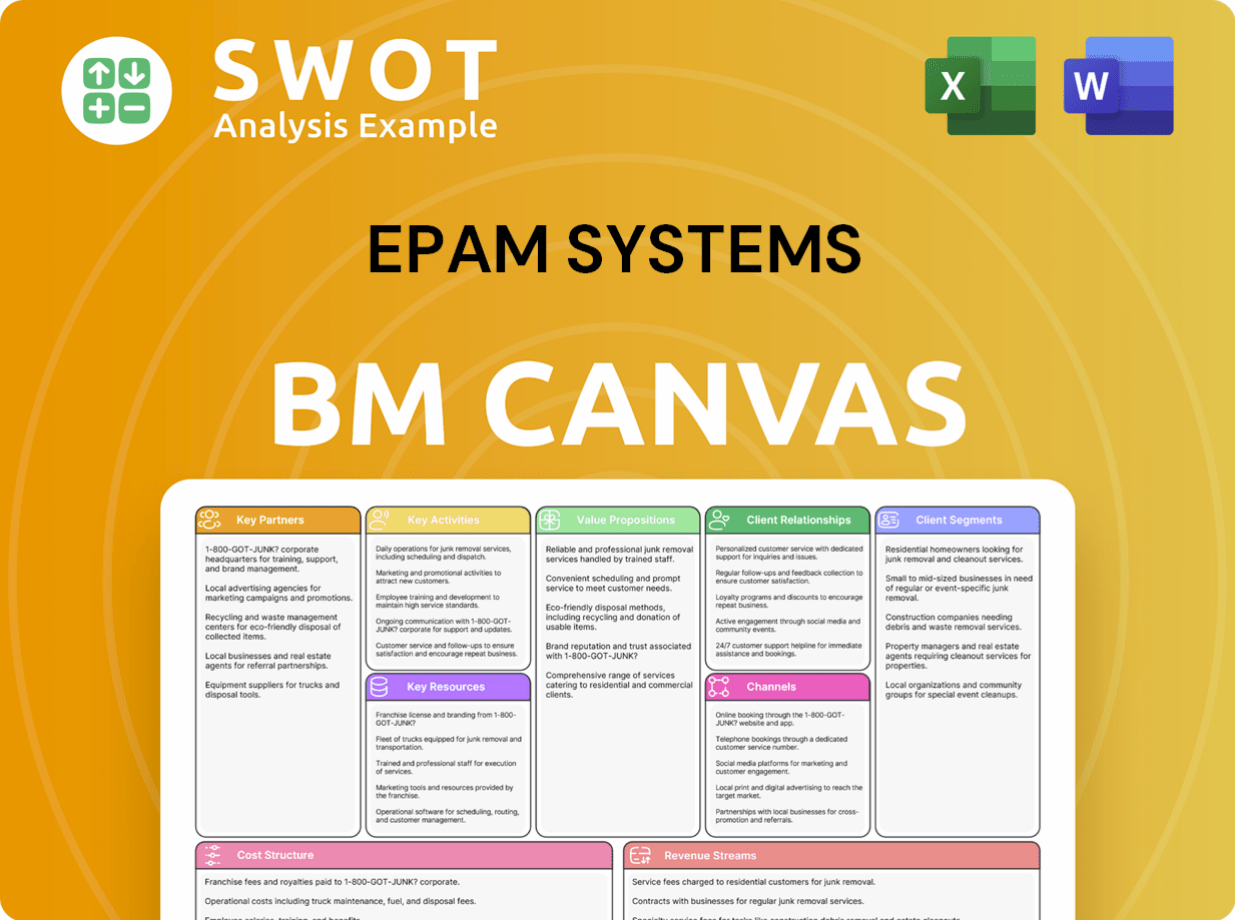
What Are EPAM Systems’s Most Notable Campaigns?
The sales and marketing strategy of EPAM Systems, a business-to-business (B2B) service provider, centers on thought leadership and industry-specific solutions. Unlike companies that focus on direct-to-consumer campaigns, EPAM's approach emphasizes building its brand as a trusted technology partner. This strategy aims to attract clients through demonstrating expertise, showcasing successful projects, and providing valuable insights in the tech industry. The company focuses on a data-driven approach to optimize its sales and marketing efforts for maximum impact.
A core element of EPAM's strategy involves consistently promoting its capabilities in areas like AI and Generative AI. This involves creating and distributing content through diverse channels. The primary goals are to position EPAM as an industry leader, generate qualified leads, and enhance its reputation for innovation. This strategy is crucial for attracting clients seeking cutting-edge technological solutions. This approach is a key part of the overall Growth Strategy of EPAM Systems.
EPAM also invests in industry-specific initiatives to showcase its deep understanding of particular sectors. These campaigns demonstrate the company's ability to deliver tailored technological solutions. These initiatives have been successful in securing contracts with major players, contributing to the company's revenue growth. The effectiveness of these initiatives is reflected in EPAM's strong financial performance. In Q1 2024, EPAM reported revenue of approximately $1.15 billion, highlighting the success of its sales and marketing strategies.
EPAM consistently highlights its expertise in AI and Generative AI to position itself as a leader in enterprise transformation. This includes webinars, whitepapers, and case studies shared on its website and through LinkedIn. The goal is to generate leads for AI-driven projects and enhance its innovative reputation.
EPAM develops tailored solutions for specific industries, such as financial services, healthcare, and retail, to demonstrate its deep understanding of industry challenges. This includes creating industry-specific content and participating in relevant conferences. These efforts aim to secure contracts and drive revenue growth within these sectors.
EPAM's digital marketing approach relies heavily on content creation to engage its target audience. This includes blog posts, articles, and reports that provide valuable insights into technology trends and industry best practices. The focus is to attract and retain potential clients by offering informative and useful content.
Showcasing client success stories is a key element of EPAM's marketing strategy. These stories demonstrate the value of EPAM's services and build trust with potential clients. These case studies are used to illustrate the impact of EPAM's solutions and attract new business opportunities.
EPAM's sales performance metrics include website traffic, engagement with AI-related content, and the number of qualified leads generated. The company closely monitors these metrics to assess the effectiveness of its marketing campaigns and optimize its strategies. EPAM's strong financial results, including the $1.15 billion in revenue reported in Q1 2024, reflect the success of its sales and marketing efforts.
- Website Traffic: Monitoring the number of visitors to AI-related content.
- Lead Generation: Tracking the number of qualified leads for AI-focused services.
- Revenue Growth: Assessing the impact of marketing campaigns on overall revenue.
- Client Acquisition: Measuring the number of new clients secured through marketing efforts.
EPAM Systems Porter's Five Forces Analysis
- Covers All 5 Competitive Forces in Detail
- Structured for Consultants, Students, and Founders
- 100% Editable in Microsoft Word & Excel
- Instant Digital Download – Use Immediately
- Compatible with Mac & PC – Fully Unlocked
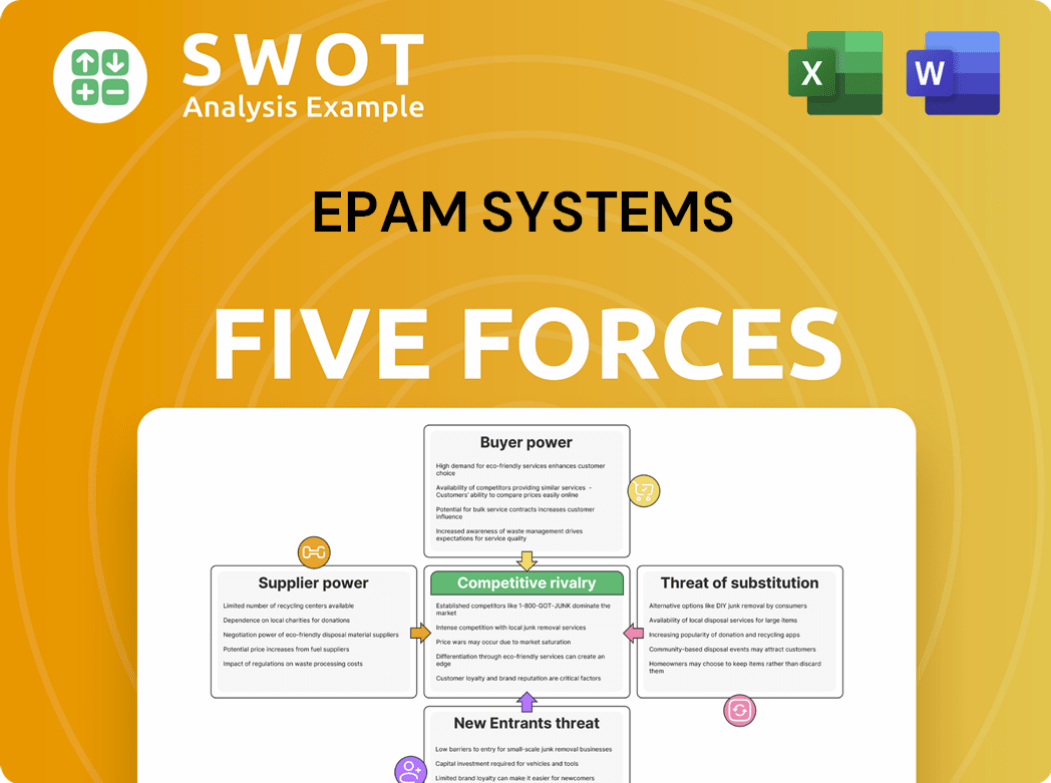
Related Blogs
- What are Mission Vision & Core Values of EPAM Systems Company?
- What is Competitive Landscape of EPAM Systems Company?
- What is Growth Strategy and Future Prospects of EPAM Systems Company?
- How Does EPAM Systems Company Work?
- What is Brief History of EPAM Systems Company?
- Who Owns EPAM Systems Company?
- What is Customer Demographics and Target Market of EPAM Systems Company?
Disclaimer
All information, articles, and product details provided on this website are for general informational and educational purposes only. We do not claim any ownership over, nor do we intend to infringe upon, any trademarks, copyrights, logos, brand names, or other intellectual property mentioned or depicted on this site. Such intellectual property remains the property of its respective owners, and any references here are made solely for identification or informational purposes, without implying any affiliation, endorsement, or partnership.
We make no representations or warranties, express or implied, regarding the accuracy, completeness, or suitability of any content or products presented. Nothing on this website should be construed as legal, tax, investment, financial, medical, or other professional advice. In addition, no part of this site—including articles or product references—constitutes a solicitation, recommendation, endorsement, advertisement, or offer to buy or sell any securities, franchises, or other financial instruments, particularly in jurisdictions where such activity would be unlawful.
All content is of a general nature and may not address the specific circumstances of any individual or entity. It is not a substitute for professional advice or services. Any actions you take based on the information provided here are strictly at your own risk. You accept full responsibility for any decisions or outcomes arising from your use of this website and agree to release us from any liability in connection with your use of, or reliance upon, the content or products found herein.